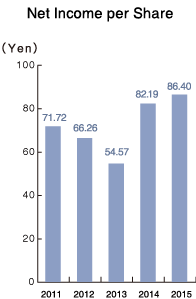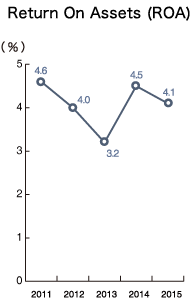Financial Review
USHIO INC. and Consolidated Subsidiaries
Year ended March 31, 2015
The USHIO Group—comprising the parent company and its 54 consolidated subsidiaries and 2 equity-method affiliates—engages mainly in manufacturing and marketing light sources, equipment, and machinery for industrial uses. The Group also engages in research and development and provides other services related to its businesses.
-
Economic Trends and USHIO’s Response
In the fiscal year ended March 31, 2015, the global economy saw moves toward revival in Europe, centering on Germany and the UK, and the U.S. economy recovery was steady, even as the tempo of expansion in the Chinese economy went down a notch. In Japan, a gradual recovery continued with signs of brisk demand in personal spending and improvements in the corporate sector.
In the cinema-related markets, which are key markets for the USHIO Group’s imaging equipment and light sources, of 140,000 screens worldwide, about 95% already use digital projectors; however, in developing markets, including China, the number of movie theaters and screens continues to increase. In the general imaging market outside of cinemas, growth is steady in the industrial and entertainment fields in developed countries such as the U.S.
In the electronics market, a key market for the USHIO Group’s optical equipment and light sources, robust demand for smartphones led to maintenance of high production line capacity utilization rates among our customers, but demand continued to be sluggish for high-priced devices such as for packaging with top-end PCs.
Under these economic conditions, the USHIO Group continued to actively execute R&D investments in new technologies and products for the future. At the same time, the USHIO Group remained focused on making Group-wide efforts to improve its business results by raising productivity, lowering manufacturing costs, reducing expenses, building and expanding global production and sales systems, and promoting production in optimal locations.
-
Earnings
During the fiscal year ended March 31, 2015, sales increased while income decreased.
Net sales
Consolidated net sales increased 1.0% year on year to \159,365 million. In the equipment business, general imaging was firm for all types of uses, but this was not enough to make up for the reduced sales of digital cinema projectors. In optical equipment, sales were down as a result of contraction in the EUV light sources business and sluggish sales of lithography equipment for electronic component manufacturing, and delays caused by acceptance inspections for some optical alignment equipment. In the light sources business, xenon lamps for cinema projectors, data projector lamps and halogen lamps for office automation equipment performed strongly, in addition to increased sales of solid-state light sources, which contributed to increased profits.
Operating income
Operating income declined by 14.5% year on year to \10,357 million. In the equipment business, the Group recorded a segment loss, due to the contraction of the EUV business and a slump in sales of optical equipment, although it recorded income of \10,000 million from brisk sales of discharge lamps and halogen lamps in the light sources business.
Net income
Net income increased 4.7% year on year to ¥11,279 million. The improvement was attributable to extraordinary income of \3,600 million from sales of stock held, offsetting the decrease in ordinary income.
-
Results by Business Segment
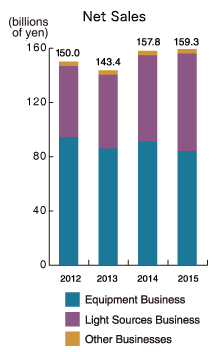
Equipment Business
The equipment business saw sales decrease 7.7% year on year to ¥84,188 million, recording a segment loss of ¥36 million.
In the imaging equipment sub-segment of the business, digital cinema projectors have achieved a high rate of penetration centered on developed markets, resulting in a recent decrease in shipments year on year and a slump in demand. In general imaging equipment, demand was firm for various types of imaging equipment for entertainment, including various events, large halls and amusement parks, as well as for industrial uses with simulation and virtual reality systems, and control rooms.
In the optical equipment sub-segment, supported by brisk demand for smartphones and tablets, demand was firm for lithography for various types of devices, optical alignment equipment for high-definition LCD panels and some lithography devices for PCBs. But in addition to the contraction of the EUV light source business, demand for PCB lithography equipment for packaging PCs was sluggish and the effects of an acceptance inspection, which caused delays longer than envisaged, resulted in a reduction of devices sold.
Light Sources Business
Sales in the light sources business increased by 13.7% year on year to ¥73,014 million. Segment profit was up by 7.3% year on year to ¥10,074 million.
The light sources business overall performed strongly, aided by the impact of the weak yen. UV lamps for lithography held firm as capacity utilization rates at semiconductor manufacturers remained high and replacement demand went well, but longer replacement cycles resulted in flat sales. Shipments of xenon lamps for digital cinema projectors are decreasing, but the total number installed has continued to increase mainly in developing countries. Steady sales continued for both high-end and low-end lamps for data projectors. In solid-state light sources, sales increased as demand for laser light sources for projectors expanded and USHIO OPTO SEMICONDUCTORS, INC., an operator of businesses for semiconductor lasers for industrial and consumer use and LEDs, joined the USHIO Group. Halogen lamps sold strongly, backed by brisk demand for lamps from office automation equipment set manufacturers.
Other Businesses
Sales in other businesses increased by 11.9% year on year to ¥3,411 million and segment profit increased by 126.1% year on year to ¥175 million.
Demand was strong for plastic molding machines and image inspection apparatus for plastic molding machines.
-
Sources of Funds and Liquidity
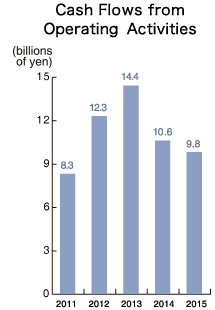
Cash Flows
Cash and cash equivalents on March 31, 2015 totaled \56,989 million, up \11,646 million from the previous fiscal year-end. Cash flows are broken down as follows:
Cash Flows from Operating Activities
Operating activities in the fiscal year ended March 31, 2015 provided net cash of \9,876 million (compared with net cash of \10,622 million provided in the previous year). The main positive contributions to this result were ¥15,545 million in income before income taxes and minority interests, a \5,919 million adjustment for depreciation and amortization, and a decrease in in notes and accounts receivable – trade of \3,412 million. Meanwhile, factors reducing cash included a \3,296 million gain on sales of investment securities, a \6,574 million increase in inventories and income taxes paid of \5,271 million.
Cash Flows from Investing Activities
Investing activities provided net cash of \3,701 million (compared with net cash used of \4,476 million in the previous fiscal year). The main factors increasing cash were proceeds from withdrawal of time deposits of \13,005 million, proceeds from sales and redemption of securities of \4,063 million and proceeds from sales and redemption of investment securities of \4,931 million. The main factors decreasing cash were an increase in time deposits of \12,975 million, purchase of securities of \1,240 million, purchase of property, plant and equipment of \4,092 million, purchase of investment securities of \2,619 million, purchase of shares of subsidiaries resulting in change in scope of consolidation of \1,815 million and payments for transfer of business of \2,588 million.
Cash Flows from Financing Activities
Financing activities provided net cash of ¥1,210 million (compared with ¥6,670 million used in the previous fiscal year). The main factors increasing cash were a net increase in short-term loans payable of ¥2,600 million and proceeds from long-term debt of ¥5,941 million. Against this, factors decreasing cash included repayment of long-term debt of ¥3,482 million, and cash dividends paid totaling ¥3,388 million.
-
Financial Position
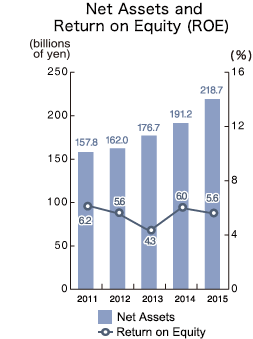
Assets
At the fiscal year-end, assets totaled \294,542 million, an increase of \39,203 million from the previous fiscal year-end. The main factors behind this increase were increases in cash and deposits, due to an increase in notes payable to banks, and investment securities, due to unrealized gains on holdings of investment securities.
Liabilities
At the fiscal year-end, liabilities totaled \75,818 million, an increase of \11,726 million from the previous fiscal year-end. The main factors behind this increase were increases in short-term loans payable and in current portion of long-term loans payable and increased deferred tax liabilities due to increased unrealized gains on holdings of investment securities.
Net assets
At the fiscal year-end, net assets totaled \218,723 million, an increase of \27,476 million from the previous fiscal year-end. The main factors behind this increase were increases in foreign currency translation adjustments due to a weaker yen, valuation difference on available-for-sale securities due to increased unrealized gains on holdings of investment securities, and retained earnings due to a revision of accounting standards related to retirement payments.
-
Capital Expenditures
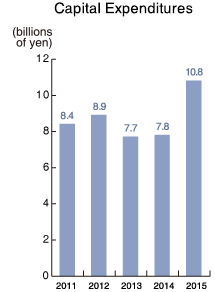
The USHIO Group’s capital expenditures for the fiscal year ended March 31, 2015 were \10,898 million. The bulk of this expenditure was for capital investment in the light sources and equipment businesses, with investments focused on building up existing facilities, as well as on businesses promising growth in future, and research and development. A breakdown of capital expenditures for the fiscal year was as follows. (Figures are calculated on an acceptance basis for property, plant and equipment, intangible fixed assets, and long-term prepaid expenses. Amounts do not include consumption tax or other levies.)
2015 Y-o-Y Change Light sources business ¥3,560
million172.3
%Equipment business ¥6,753
million121.7
%Other business ¥584
million216.2
%Total capital expenditures ¥10,898
million138.2
%Capital expenditures increased in the fiscal year ended March 31, 2015. This reflected the fact that in every segment the Group continued to make key investments aimed at strengthening the Group’s operational competitiveness in potential growth fields, while selecting investments rigorously and focusing on capital efficiency.
The USHIO Group’s investments focused mainly on the equipment and light sources businesses. In the equipment business, the Group focused its expenditure on optical equipment including lithography equipment and optical processing equipment targeting diversifying market needs, as well as laser projectors and sound systems in visual imaging fields, and simulation systems and virtual reality in general imaging fields. In the light sources business, the Group focused primarily on expenditure to maintain its high quality and technological advantages and to expand its solid-state light sources (LEDs and laser diodes) business.
The Group funded its capital expenditures with a combination of internally generated funds and borrowings.
Loss on retirement of non-current assets was \69 million, due to the disposal of plant facilities such as buildings and machinery in the light sources and equipment businesses.
-
Research and Development
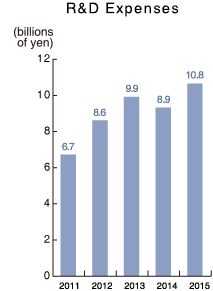
Group-wide R&D expenses totaled \10,880 million. Most of this was spent in the light sources and equipment businesses. The main targets of the Group's R&D were light sources for industrial applications for development and production, which included work use and application of optical applications in electronic and electromechanical equipment, moving ahead with development of indispensable peripheral technologies and development for commercialization of optical units, optical equipment and systemization. The Company stepped up its efforts to keep abreast of the latest developments in markets and technology and conducted strategic R&D activities. It is organized in a way that enables interaction among the R&D teams from different product groups to encourage development of new kinds of light sources and equipment.
The USHIO Group’s key achievements during the fiscal year ended March 31, 2015 were as follows:
Light Sources Business
Development of an Wirelessly Controlled LED Bar Unit for Crop Raising, Offering Wireless Control of Light Variation and Illumination Times
USHIO LIGHTING, INC., a subsidiary that develops wireless control LED bar units for plant growth developed Japan’s first wireless controlled LED bar unit for plant growth applications.
Many horticultural factories have been either unable to control scheduling of light variation or illumination times, or need to install wired devices to control these factors.
However, with a variety of plants to grow and being unable to grow them with a set light source, existing wired controls have the problem of costing time and money due to complicated wiring and control panels required for each shelf and setting changes.
Utilizing technologies and expertise cultivated in LED heat radiation, LED element applications and optical design, and fusing these with wireless technology from ROHM semiconductors enabled production of a wireless-controlled LED bar unit for plant growth application.
This development enabled easy wireless light variation and schedule control, while simple wiring construction charges cut costs, and with all layout and schedule changes possible through computer operation, the task has become easier and more flexible.Equipment Business
1) Temperature measurement module for halogen heaters measuring accurately while adjusting for ambient light
The USHIO Group has developed the world’s first temperature measurement module for halogen heaters that measures the temperature of heated objects while correcting the impact of ambient light to provide accurate, non-contact measurements.
Halogen heaters are used for numerous purposes including heating, drying, property modification and water removal. Managing the temperatures of these items has emphasized avoiding damaging heated objects and therefore measurements are often made surrounding the heated objects rather than the heated object itself, which presents a challenge.
A temperature measurement module has been developed that adjusts for the impact of ambient light shone from the halogen heater on the radiation thermometer to enable accurate measurement of the temperature of the heated object in a non-contact, real-time manner. Measured data is fed back and enables real-time temperature control of heated objects.
Not only quality of temperature control enhancements has been made, but halogen heaters can now be used where once their application had not been possible with convention radiation thermometers because of inaccurate measurements.2) High luminescence, lightweight 4K30 projector developed for rental staging
CHRISTIE DIGITAL SYSTEMS CANADA INC., a wholly owned subsidiary, developed the Christie® Boxer 4K30 with high luminescence, 3DLP picture quality in a compact, lightweight yet robustly housed design.
This projector for rental stages, such as those used at concerts, theme parks and projection mapping, is of the highest performance level in the industry. Illumination using six 450W mercury lamps enables center brightness of 30,000 lumens.
For a 30,000-lumens-class projector, this is extremely compact and lightweight, cutting transport costs and simplifying on-site installation. The projector not only provides the ultimate in compact formation and outstanding luminescence, but it also has highly flexible, simple settings enabling horizontal, vertical or angled placement.
In addition, NFC tracking enabling users to monitor the use time and serial numbers of individual lamps has largely eliminated the labor involved in confirming lamp life, making it possible to rapidly exchange lamps on-site without having to stop shows. -
Issues to Be Addressed
Looking ahead at the business environment for the USHIO Group, modest economic recovery and expansion is projected to continue domestically and in the global economy. In electronics field, the markets for LCD panels, semiconductors, and other electronic components are expected to benefit from continuing strong sales of smartphones and tablet PCs, however, weaker market growth is projected and future prospects is unclear. Meanwhile, the imaging equipment-related market is witnessing declining sales of digital cinema projectors. This reflects a slowdown in the number of new digital cinema screens installed annually in developed markets, where use of digital projectors is now well established, although further growth in new installations of digital cinema screens is still anticipated in China and other emerging markets.
The Group will address these developments in its business environment and markets, taking steps to expand its operations by making active strategic investments to develop new products, find new applications for its products, and launch new products and businesses. The Group will also enhance its product lineup to respond to diversifying market needs, reduce manufacturing costs throughout its operations, and improve quality and productivity. In addition, the Group will endeavor to expand and reinforce its manufacturing bases as well as its sales bases and networks both in Japan and overseas. In doing so, it aims to optimize its service structure and develop a more proposal-oriented total-solution type business to expand its sales of light sources, optical equipment, and imaging equipment to global markets. The Group will not limit itself to in-house development, but will also seek to develop dynamic businesses by considering business partnerships, investments, or other options.
The USHIO Group regards environmental issues as a key management concern in terms of corporate social responsibility, and will continue to take active steps to save energy and resources, cut waste, increase recycling, and otherwise reduce its environmental footprint. Meanwhile, the Group will continue with measures to ensure that it merits the trust of all its stakeholders. These will involve optimizing its internal control systems by bolstering corporate governance and compliance, and ensuring continued stability in its operations by putting in place the best possible provision for risk management including business continuity planning.
-
Risks
Below is a summary of risks that could affect the USHIO Group’s business performance, financial position, and cash flow adversely and materially. These are the risks cited by management in the Group’s Yukashoken Hokokusho (Annual Securities Report) to the Japanese government, filed on June 26, 2015. This is only a partial listing, and the Group faces risks other than those cited here that could also affect its business performance, financial position, and cash flow materially.
(1) Market Demand Fluctuations in Semiconductors and LCDs
The Group’s business performance is sensitive to demand fluctuations in the semiconductor and LCD industries. Currently, the USHIO Group’s principal products for those industries are replacement lamps for manufacturing equipment, which is consumable, and demand for these lamps is generally steady while customer plants are operating. However, the semiconductor and LCD manufacturing equipment targeted by the Group is subject to changes in demand for products in the short-term and the medium-to-long-term, as well as to technological developments. Unexpected changes in demand or technological progress could affect the Group’s business performance and financial position materially.
(2) Market Demand Fluctuations for Light Sources for Illumination and Irradiation
Outside of the semiconductor and LCD panel fields, the Group supplies light sources for installation in data projectors, illumination and irradiation light sources for digital cinema projectors and other equipment, and visual imaging equipment and light sources. Trends in technology and fluctuations in prices and demand for these light sources could affect the Group’s business performance and financial position materially.
(3) Access to Raw Materials
The Group relies on externally sourced raw materials, which it obtains from a broad range of suppliers to ensure steady supplies of high-quality materials at stable prices. Rare metals such as tungsten and molybdenum are crucial raw materials for manufacturing lamps in particular. Supply shortages or price increases of those materials could increase the cost of manufacturing and affect the Group’s business performance and financial position materially.
(4) Developing Lithography Technology for Semiconductor Manufacturing
As semiconductor microcircuitry patterns become increasingly miniaturized, the number of semiconductor manufacturing equipment using the Group’s discharge lamps remains high. However, semiconductor manufacturing is beginning to shift to other lithography technologies. The nature of future developments in lithography technology for manufacturing semiconductors could affect the Group’s business performance and financial position materially.
(5) Cross-Border Activities and Entry into Overseas Markets
The Group conducts manufacturing and sales activities in regions outside Japan, specifically other Asian nations, North America, and Europe. Entry into these overseas markets is associated with potential risks in each country that include changes in various rules and regulations, instability in securing human resources, underdeveloped infrastructure, and social unrest. If realized, these risks could affect the Group’s business performance and financial position materially.
(6) Intellectual Property
The Group operates in business sectors characterized by frequent technological advances. Protecting, maintaining, and managing patents, trademarks, and other intellectual property are influential factors in competitiveness and market share in those business sectors. Litigation could arise if a third party were to infringe on the Group’s intellectual property rights or if the Group were to infringe on a third party’s intellectual property rights. In addition, the patent authorities could refuse patent applications submitted by the Group. Any such event that would significantly comprise the Group’s protection of its intellectual property rights could affect the Group’s business performance and financial position materially.
(7) Currency Exchange Rates
The Group conducts its commercial and financial operations in yen and in other currencies. Profits and losses in the Group’s commercial and financial operations conducted in foreign currencies are therefore subject to the influence of fluctuations in currency exchange rates. The Group uses forward exchange contracts to moderate currency exchange risk, but it cannot negate that risk completely. Fluctuations in the foreign exchange rates could therefore affect the Group’s business performance and financial position materially.
(8) Fluctuations in Prices of Marketable Securities
The Group holds marketable securities as financial assets. Depending on stock market and other conditions, the fair value of these securities could decline. Therefore, the Group is exposed to the risk of fluctuations in the prices of marketable securities, which could affect the Group’s business performance and financial position materially.
-
Important Management Contracts
USHIO INC. decided at a Board of Directors meeting held on May 9, 2014 to execute a share exchange agreement with ADTEC Engineering Co., Ltd. in which USHIO will be a wholly owning parent company and ADTEC Engineering will be a wholly owned subsidiary, effective from August 1, 2015.
For details, refer to Note 5: Status of Accounts Notes to the Consolidated Financial Statements (Business Combinations and Related Matters).
